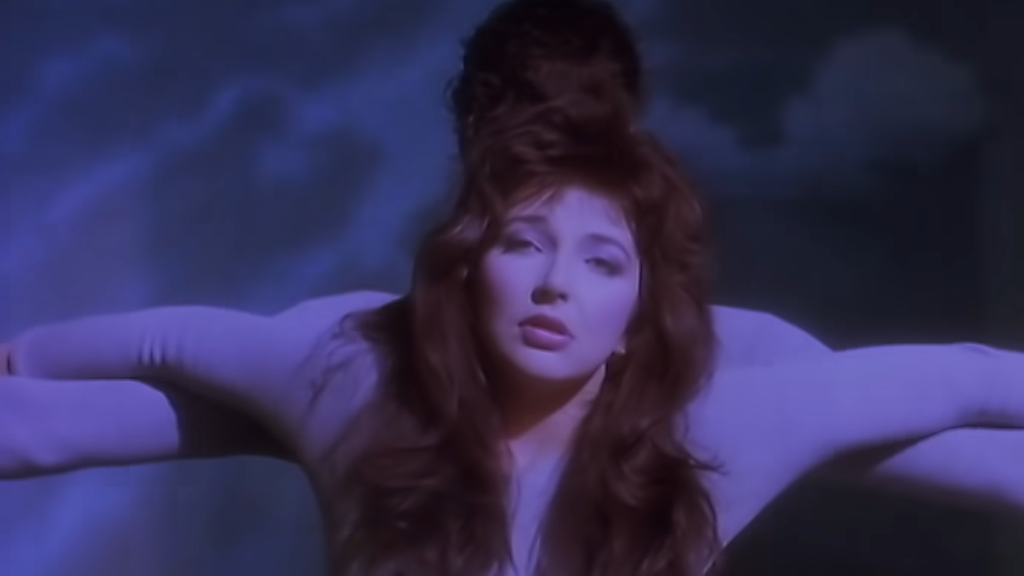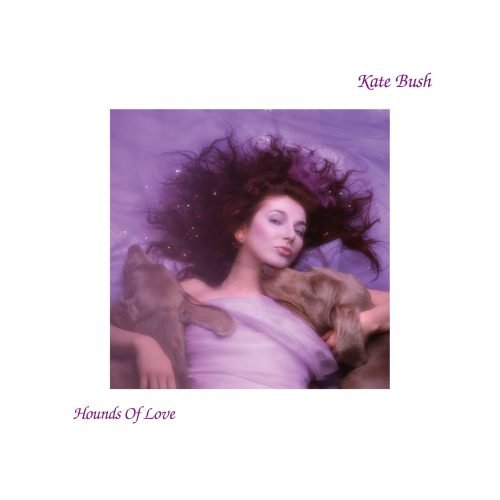In the lush tapestry of pop music history, Kate Bush’s Hounds of Love stands out as a monumental achievement, not just within her discography but also in the broader music landscape of the 1980s. Released in 1985, the album arrived at a time when Kate Bush was already established as a unique and innovative artist, known for her ethereal voice, intricate compositions, and avant-garde music videos. However, Hounds of Love is often seen as the zenith of her artistic exploration, merging the ethereal with the earthly, the narrative with the abstract, in ways few artists had dared to attempt.
Bush’s fifth studio album, Hounds of Love, is both a continuation of and a departure from her previous work. It deepens the introspective and experimental nature of her music, while also embracing a more accessible pop sensibility that hadn’t been as pronounced in her earlier albums. This balance between experimentalism and accessibility is part of what makes the album a masterpiece. It is divided into two distinct parts: “Hounds of Love,” a collection of five pop-oriented songs that include hits like “Running Up That Hill (A Deal with God)” and the eponymous track “Hounds of Love”; and “The Ninth Wave,” a conceptual and thematic suite of songs that tells a story across its tracks, showcasing Bush’s ambitious narrative and musical scope.
Artistic Intentions

Kate Bush’s artistic intentions with Hounds of Love were multifaceted. She sought to create an album that was both musically rich and lyrically deep, exploring themes of love, fear, and the human condition. Bush has been somewhat reticent about the specifics of her creative process, preferring the work to speak for itself, but interviews and album notes suggest that she was deeply involved in every aspect of the album’s creation, from writing and performing to producing and mixing. This holistic approach to the album’s production allowed her to fully realize her artistic vision, creating a soundscape that was entirely her own.
“I wrote the songs for this album in a tiny room overlooking endless fields. I could see the weather coming for miles…”
Kate on writing Hounds of Love
Moreover, the album’s innovative use of technology—particularly the Fairlight CMI (Computer Musical Instrument), which allowed Bush to sample and synthesize sounds in groundbreaking ways—further underscored her intent to push the boundaries of what pop music could be. Through Hounds of Love, Bush not only solidified her reputation as a pioneering musician and producer but also laid down a marker for female artists in the industry, demonstrating the possibilities of having complete creative control over one’s work.
In the context of its time, Hounds of Love was a bold statement. It arrived amidst the synth-pop and rock dominance of the mid-80s, carving a niche that was distinctly Bush’s. Its success—both critically and commercially—underscored the public’s readiness for music that challenged norms, embraced complexity, and delved deep into emotional landscapes. Kate Bush’s Hounds of Love is more than just an album; it’s a journey into the heart of an artist unafraid to explore the depths of her creative vision.
Sonic Exploration

The production quality of Kate Bush’s Hounds of Love is an exquisite example of clarity and depth, serving as a testament to Bush’s prowess as both an artist and a producer. Unlike many albums of its era, which leaned into the burgeoning digital clarity of the 1980s or the raw energy of lo-fi aesthetics, Hounds of Love strikes a remarkable balance. It utilizes the era’s technological advancements to create a sound that is both pristine and emotionally resonant. The album’s use of the Fairlight CMI was revolutionary, allowing Bush to weave complex layers of sound that create a lush, immersive listening experience. This clarity of production does not strip away the emotional weight of the music; instead, it enhances it, making the listener feel as though they are stepping into a meticulously crafted sonic world.
Musical Arrangements
The musical arrangements on Hounds of Love are nothing short of groundbreaking. Bush’s use of traditional instruments alongside then-cutting-edge synthesizers and sampling technology results in a sound that is timeless yet utterly distinctive. The album opens with the pulsating rhythms of “Running Up That Hill (A Deal with God),” where the driving beat and the ethereal synthesizer textures set the tone for the album’s exploration of human emotion and desire. The title track, “Hounds of Love,” juxtaposes urgent strings with a playful, almost menacing rhythm section, creating a sense of chase and exhilaration.
Perhaps the most striking arrangements are found in “The Ninth Wave,” where Bush experiments with a diverse array of sounds—from the haunting a cappella harmonies in “And Dream of Sheep” to the dramatic, orchestral swells in “The Morning Fog.” These arrangements not only showcase Bush’s vocal versatility but also her ability to tell a story through music, with each track contributing to a larger narrative journey.
Genre Elements
Genre-wise, Hounds of Love is a kaleidoscope of influences, touching upon art pop, progressive rock, and elements of folk and classical music. This blending of genres is both innovative and respectful, acknowledging the roots of each style while pushing their boundaries. The album’s first half leans more towards pop and rock, with tracks like “Cloudbusting” embodying a cinematic scope that bridges the gap between pop sensibility and the avant-garde. The second half, “The Ninth Wave,” could be described as a mini opera, employing elements of classical music and folk to tell its story. This seamless integration of genres demonstrates Bush’s refusal to be confined by traditional labels, opting instead to create a sound that is uniquely her own.
Lyrical Analysis

The lyrical landscape of Kate Bush’s Hounds of Love is a rich tapestry, weaving together themes of love, fear, spirituality, and human resilience. These themes are not merely visited; they are explored with depth, nuance, and a poetic grace that elevates the album to a form of musical literature. Bush’s lyrics serve as the emotional and narrative backbone of the album, guiding the listener through a series of interconnected stories and introspective journeys that resonate long after the final note has faded.
Central to the album is the exploration of love in its many forms—romantic, platonic, and the love between humanity and the natural world. The opening track, “Running Up That Hill (A Deal with God),” delves into the desire for understanding between people, proposing a metaphysical swap of places to achieve empathy. This quest for connection and understanding recurs throughout the album, perhaps most poignantly in “The Ninth Wave,” a suite of songs that narrates a near-death experience from the perspective of a person stranded at sea, waiting for rescue. Here, Bush explores the depths of human fear and loneliness, juxtaposed with a profound sense of hope and a yearning for life.
The lyrics throughout Hounds of Love are marked by their lyrical depth and poetic nature. Bush employs a range of literary devices, from vivid imagery to metaphor, to convey her themes. For example, “Cloudbusting” is inspired by the true story of psychoanalyst Wilhelm Reich and his son, Peter, weaving a narrative that touches on memory, loss, and the power of hope and belief. The song “The Morning Fog,” which closes the album, is a celebration of rebirth and renewal, its lyrics simple yet profound in their emotional clarity. Bush’s ability to craft lyrics that are at once specific in their storytelling and universal in their emotional appeal is a testament to her skill as a songwriter.
Emotional Impact
The emotional impact of the album’s lyrics cannot be overstated. Through her words, Bush invites listeners into a world where every emotion is felt deeply and expressed vividly. The vulnerability and strength in her storytelling evoke empathy, joy, sadness, and contemplation, often within the span of a single song. “Waking the Witch,” for example, confronts the listener with the terror of judgment and persecution, using disorienting sound effects and shifting perspectives to create a sense of urgency and fear. In contrast, “And Dream of Sheep” offers a moment of fragile beauty and longing, its lyrics conveying a deep sense of isolation and the comfort found in dreams and memories.
In Hounds of Love, Kate Bush’s lyrics are both a mirror and a window—reflecting the complexity of the human condition while offering a glimpse into the imaginative world of one of music’s most innovative artists. The album stands as a masterclass in songwriting, where every word is chosen for its ability to resonate, to move, and to transform. Through its lyrical depth and emotional resonance, Hounds of Love remains a profound artistic achievement, inviting listeners to explore the landscapes of their own hearts and minds.
Cohesion and Flow

The cohesion and flow of Kate Bush’s Hounds of Love are among its most remarkable features, creating a seamless tapestry that binds the album into a singular, cohesive work of art. This cohesion is achieved not just through the musical and lyrical elements but through a deliberate and thoughtful track progression that guides the listener through a carefully curated emotional and narrative journey.
The Album’s Structure
The album is structured in two distinct halves: the first, “Hounds of Love,” featuring more pop-oriented tracks, and the second, “The Ninth Wave,” a conceptual suite that weaves a narrative of survival and introspection. This division serves as the backbone of the album’s flow, with each half exploring different facets of the human experience while maintaining a thematic and emotional continuity that ties the entire work together.
In “Hounds of Love,” the tracks transition smoothly from one to the next, each song building upon the themes and emotions of the last. The opening track, “Running Up That Hill (A Deal with God),” sets the stage with its exploration of human empathy and connection, themes that echo throughout the album. The transition from the energetic “Hounds of Love” into the introspective “The Big Sky” illustrates Bush’s mastery of emotional pacing, guiding the listener from the exhilaration of love into a reflective appreciation of the world’s vastness and beauty.
“The Ninth Wave” takes the album’s cohesion to a deeper level, with each track not only flowing into the next but also contributing to a larger narrative arc. From the haunting “And Dream of Sheep” to the hopeful closure of “The Morning Fog,” this half of the album is a masterclass in thematic consistency and narrative storytelling. The emotional and musical motifs introduced in the album’s first half are revisited and expanded upon, creating a sense of full-circle completion by the album’s end.
Thematic Consistency
Thematic consistency is maintained with remarkable precision throughout Hounds of Love. Themes of love, fear, longing, and rebirth are interwoven with a consistency that never feels repetitive. Instead, Bush explores these themes from multiple angles, using different musical styles and lyrical perspectives to deepen the listener’s understanding and emotional engagement. The album’s diverse musical influences—from pop to folk to classical—are blended so seamlessly that the transitions feel natural rather than jarring, contributing to the album’s overall sense of unity.
Moreover, the emotional resonance of the album is carefully modulated to ensure that the listener’s journey is engaging from start to finish. The intensity of “Waking the Witch” is balanced by the serene beauty of “Watching You Without Me,” demonstrating Bush’s understanding of emotional dynamics and her skill in creating a balanced and immersive listening experience.
Standout Tracks and Moments

Kate Bush’s Hounds of Love is an album rich with standout tracks and unforgettable moments, each contributing to the tapestry that makes the work a masterpiece. While the album operates beautifully as a cohesive whole, certain tracks and specific moments within them rise to the forefront, capturing the essence of the album’s artistic merit, innovation, and emotional impact.
Key Tracks
- “Running Up That Hill (A Deal with God)” stands out not only as the album’s opening track but as a landmark in music production and emotional depth. Its exploration of empathy and human connection, combined with the innovative use of the Fairlight CMI to create its signature sound, sets it apart. The driving beat, ethereal synth textures, and Bush’s impassioned vocals create a powerful opening statement that immediately engages the listener.
- “Cloudbusting” is another track that shines brightly on the album. Inspired by the true story of Wilhelm Reich, the song blends a deeply personal narrative with a sweeping orchestral arrangement, resulting in a song that is both emotionally resonant and musically expansive. The use of strings and the melodica, along with Bush’s storytelling prowess, make “Cloudbusting” a standout track for its artistic and emotional depth.
- From the second half of the album, “The Ninth Wave” suite, “And Dream of Sheep” is particularly noteworthy. This track showcases Bush’s ability to convey vulnerability and intimacy. The simple arrangement—featuring Bush’s voice accompanied by a gentle piano and the sound of waves—creates a sense of isolation and longing that is palpable.
Memorable Moments
- The transition from the synth-driven intensity of “Running Up That Hill” to the haunting strings of “Hounds of Love” is a moment of brilliant contrast that encapsulates the album’s dynamic range. This shift not only showcases Bush’s musical versatility but also her skill in narrative storytelling through music.
- In “Cloudbusting,” the moment when the strings swell as Bush sings, “I just know that something good is gonna happen,” captures a surge of hope and defiance that is the emotional core of the song. It’s a powerful musical and lyrical crescendo that remains one of the album’s most uplifting moments.
- A particularly poignant moment occurs in “Hello Earth,” part of “The Ninth Wave” suite, where a chorus of voices joins Bush in a hauntingly beautiful arrangement that evokes a sense of otherworldly solemnity and connection. This moment, coupled with samples of a Georgian folk song, underscores the suite’s themes of human vulnerability and the interconnectedness of life.
- The final track, “The Morning Fog,” provides a moment of cathartic release as the album concludes with a message of love and gratitude. The shift to a more acoustic, folk-inspired sound in this track, combined with Bush’s warm vocals, leaves the listener with a sense of hopeful renewal. The line, “Do you know what? I love you better now,” sung with a gentle conviction, effectively captures the essence of the album’s narrative journey from darkness back into light.
Each of these tracks and moments stands out for its ability to evoke deep emotional responses, showcase innovative musical techniques, and articulate the themes that Hounds of Love navigates. Kate Bush crafted an album where innovation meets emotion, and these standout tracks and moments are pivotal in understanding the depth and breadth of her artistic vision.
Artistic Contribution and Innovation

Kate Bush’s Hounds of Love occupies a unique and revered place within the music industry and its genre, standing as a testament to the power of artistic innovation and boundary-pushing creativity. Released in 1985, the album not only solidified Bush’s status as a musical visionary but also challenged and expanded the possibilities of pop music. Its impact is profound, resonating through the industry in ways that continue to influence artists and producers.
Place in Genre/Industry
Within the broader landscape of pop and art pop, Hounds of Love is a beacon of innovation. At a time when the music industry was heavily leaning towards synthesized pop and rock anthems, Bush delivered an album that was both accessible and deeply complex. It did not merely push boundaries—it vaulted over them, blending genres, experimenting with production techniques, and delving into thematic depths rarely explored in mainstream music. The album’s commercial and critical success challenged the industry’s norms, proving that there was a vast appetite for music that was both intellectually engaging and emotionally resonant.
Innovation
- Production Techniques: One of the most innovative aspects of Hounds of Love is its use of production techniques, particularly the pioneering use of sampling technology. Bush’s mastery of the Fairlight CMI allowed her to create sounds and textures that were unheard of at the time, blending digital and analog elements to craft a soundscape that was entirely new. This innovative approach to production not only set a new standard for musical craftsmanship but also opened up new avenues for creative expression in pop music.
- Genre Blending: Bush’s refusal to adhere to a single genre, instead weaving together elements of pop, rock, folk, and classical music, marks Hounds of Love as a groundbreaking work. This eclectic mix not only showcases Bush’s diverse musical influences and talents but also challenges the notion of genre boundaries. By seamlessly integrating different styles, Bush created a sonic landscape that was rich, varied, and entirely her own.
- Thematic Exploration: The album’s thematic ambition, particularly evident in the narrative complexity of “The Ninth Wave,” represents a significant innovation in how albums could convey stories and concepts. Bush’s use of voice, sound, and structure to tell a cohesive story across multiple tracks was a bold artistic choice that has inspired countless artists to explore more complex and ambitious thematic content in their work.
- Emotional Depth: Lastly, the emotional depth and range of Hounds of Love stand out as innovative. Bush delves into the human psyche, exploring themes of love, fear, death, and rebirth with a sensitivity and insight that transcends the typical pop album. This emotional complexity, paired with the album’s musical and production innovations, creates a listening experience that is both intellectually stimulating and deeply moving.
Kate Bush’s Hounds of Love is more than just an album; it is a milestone in the evolution of pop music. Its artistic contributions and innovations have left an indelible mark on the music industry, inspiring artists to pursue their creative visions without compromise. In pushing the boundaries of what music can be, Bush not only achieved a personal artistic triumph but also expanded the horizons of the entire musical landscape.
Closing Thoughts

Photo By Guido Harari
In the pantheon of musical masterpieces, Kate Bush’s Hounds of Love stands as a monumental achievement that transcends the ordinary confines of genre and expectation. Its strengths are manifold, from the pioneering production techniques and genre-blending compositions to the profound emotional and thematic depth that permeates every track. Bush’s innovative use of technology, combined with her unparalleled artistry in songwriting and performance, sets this album apart as a landmark in music history.
The album’s weaknesses are, in fact, part of its charm. Any perceived flaws—such as the dense complexity of its arrangements or the abstract nature of its storytelling—are also what make Hounds of Love a richly rewarding experience, offering new layers of meaning and emotion with each listen. Rather than deterring the listener, these qualities invite a deeper engagement with the music, encouraging a personal exploration that mirrors Bush’s own artistic journey.
The impact of Hounds of Love on listeners is profound and enduring. It is an album that challenges and comforts, that intrigues and inspires. Its place in Bush’s career is equally significant; it represents the pinnacle of her creative expression, showcasing her ability to marry ambitious conceptual ideas with deeply personal emotional insights. Hounds of Love is not just a highlight of Kate Bush’s discography—it is a defining moment in the landscape of pop music, pushing the boundaries of what is possible in the medium.
Official Rating
Given its groundbreaking production, its bold artistic vision, and its deep emotional resonance, it is fitting to award Hounds of Love a perfect score of 10 out of 10. This rating reflects not just the technical proficiency and creative brilliance of the album but also its transformative impact on music and its listeners. Hounds of Love is a masterpiece that defies simple classification, an album that continues to inspire and captivate audiences more than three decades after its release. Its perfection lies in its ability to connect with the listener on a profound level, offering a musical experience that is as timeless as it is innovative.
